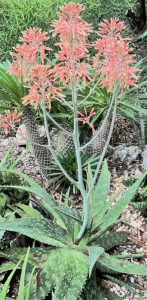
Aloe plants are very popular due to their Its adaptability to a variety of conditions. Besides the ever-familiar Aloe vera plant, there is another species known as the soap aloe or Aloe maculata. Very ornamental and a great beginner plant for succulent growers, soap aloe will not fail to meet and exceed your expectations. Having problems growing succulents? The soap aloe plant may help turn your gardening thumb, green!
The soap aloe is a succulent plant in the lily Family originally found in Africa where its sap was traditionally used as a soap substitute. As a precautionary note, one resource indicated that while the sap from the leaves will make a sudsy foam, too much can cause irritation. This aloe is well adapted to droughty conditions and less-than-wonderful soil. Soap aloe is highly salt-tolerant as well. This aloe can be grown in a pot using well-drained soil suitable for cacti. Place it in full sun area and make sure not to overwater – that also means no excess water sitting in the saucer underneath the pot. Repotting may be required from time to time as the plant grows. Step it up into a pot just a bit bigger than the old one as too big of a container could hold excess moisture and trigger a root rot situation.
As a Florida-Friendly Landscaping™ groundcover, soap aloes – and other members of this plant family – do well in full sun to part shade areas with well-drained soil. If planted in the landscape within a rock-garden, consider raising the planting bed to assure excellent drainage. Water to establish the plants, but from then on allow them to survive on rainwater alone. Original plants will develop side-shoots and gradually fill in an area with additional plants. Each white-spotted leaf margin is armed with sharp spines, so plan before you plant in consideration of passersby. Mature plants will eventually produce flower stalks that can grow upwards to two-feet tall decked out with attractive showy yellow and red flowers during the growing season. Hummingbirds are attracted to these tubular flower clusters, so keep an eye out for this added bonus. Soap aloes can hybridize and there are a variety of named cultivars. For the collector, and for a change of pace, there is an all-yellow flower cultivar called ‘Yellow Form’ that is distinctly different. Another cultivar is ‘Jack-O-Lantern’ with all orange flowers.
The soap aloe is a treat for the eyes and an almost guaranteed success for any gardener. Succulent gardens are very popular these days, and the soap aloe may make a great first addition to yours! For more information on all types of plants for your garden, you can also call the Master Gardener Volunteer Helpdesk on Mondays, Wednesdays and Fridays from 1 to 4 pm at 764-4340 for gardening help and insight into their role as an Extension volunteer. Ralph E. Mitchell is the Director/Horticulture Agent for UF/IFAS Extension Charlotte County. He can be reached at 941-764-4344 or ralph.mitchell@charlottecountyfl.gov. Connect with us on social media. Like us on Facebook @CharlotteCountyExtension and follow us on Instagram @ifascharco.
Resources:
Gardening Solutions (2015) Soap aloe. The University of Florida Extension Service, IFAS
The Florida-Friendly Landscaping™ Guide to Plant Selection & Landscape Design, 1st ed. (2010). The University of Florida Extension Service, IFAS
Christman, S. (2000) Aloe Saponaria. Floridata.
World of Succulents (2022) Aloe maculata ‘Yellow-Form’. https://worldofsucculents.com/aloe-maculata-yellow-form/ .
San Marcos Growers (2022) Aloe maculata ‘Jack-O-Lantern’ – Orange Soap Aloe. https://www.smgrowers.com/products/plants/plantdisplay.asp?plant_id=3737
The National Gardening Association – Plant Data Base (2022) Aloe maculata Soap aloe. https://garden.org/plants/view/71525/Soap-Aloe-Aloe-maculata/
Winter, N. (2017) Soap aloe offers striking foliage, gorgeous flowers that hummingbirds love. UGA Extension Service.
Source: UF/IFAS Pest Alert



